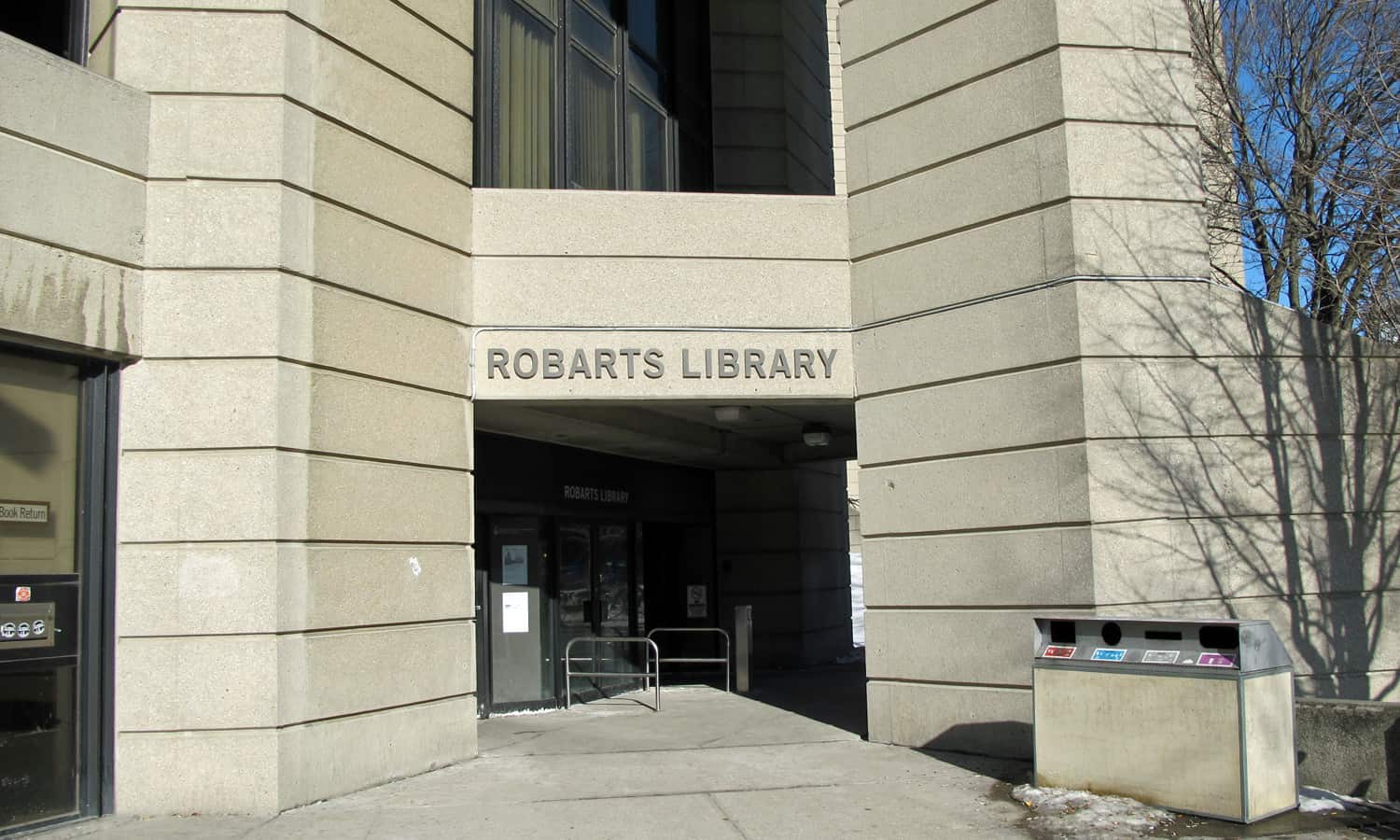Robarts Library
“It evokes medieval castles, with its blank facades below and narrow slot windows above, and Gothic cathedrals, with its colonnades and echoing entrance halls. Then there are its whimsical geometric ornaments everywhere, triangles within triangles nested in triangles across the ceiling. There are grand, canted staircases, and vertiginous gaps between floors. It is a boldly aesthetic object that answered the university’s wish, in the late 1960s, for a gutsy building.”
Alex Bozikovic, Reviving Fort Book, 2011
As the main humanities and social sciences library of the University of Toronto, the complex was designed to address the baby boom generation and dramatic expansion of graduate-level research. The John P. Robarts Research Library is a three-tower complex that includes the Thomas Fisher Rare Book Library and what is now the Faculty of Information (Claude T. Bissell Building). When completed in 1973, Robarts was the largest university library building in the world and the second largest university library collection in North America. The concrete monolith, known as “Fort Book”, was once one of the most polarizing buildings in Toronto. Today, it is recognized internationally as an exemplar of Brutalism within the Modern Movement.
The Robarts Library was situated on a downtown city block bound by St. George St., Sussex Avenue, Huron St., and Harbord St., as part of the University of Toronto’s west campus. The project was a joint venture between American architects Warner Burns Toan Lunde and Toronto architects Mathers and Haldenby. The Toronto firm had completed a number of buildings for the University of Toronto, including the Sigmund Samuel Library. Warner Burns Toan Lunde are known for major library buildings at Emory University, Princeton, Brown, and Oberlin College.
The creation of a major humanities library for the University of Toronto arose from the 1959 McLaughlin report, which called for central library expansion of 20,225sq.m. Further developments led to an announcement in 1965 by President Claude Bissell that the university’s centennial project would be a humanities and social sciences research library incorporating a library school, at a cost of $10 million. By 1973 when the entire project was complete, the complex had grown to 14 stories above ground, an area of 96,200sq.m., and a cost of $42 million.
Within a neighbourhood characterized by brick houses and mid-rise academic buildings, the library complex is comprised of three triangular forms: the 14 storey humanities and social sciences library, the 7 storey building to the north for the faculty of library sciences, and the 6 storey building to the south for rare books. As David Langdon has observed, “It is impossible to ignore the many references to Kahn’s Yale University Art Gallery, which spectacularly embedded the purity of the triangular motif into concrete fifteen years earlier, and whose famous coffered ceiling finds itself directly quoted in the waffle-slab floors of Robarts.”
The architects were particularly successful with the integration of buildings systems. Structure, architecture, and comfort systems achieve a cohesion and synthesis that is still apparent today. Inside and out, Robarts Library is characterized by the use of exposed poured-in-place and precast concrete. Monumental stairs, multi-storied interior spaces, and vertical slit windows, contribute to a monumental and fortress-like character. The Robarts Library is an extreme example of what is now termed Brutalism. With its sense of permanence, the library could not be further from the transparency and delicacy of the steel and glass curtain wall buildings of the 1950s and 1960s.
The library was named after John P. Robarts (1917-1982), the seventeenth Premier of Ontario and a companion of the Order of Canada. It is also associated with Claude T. Bissell (1916-2000), the eighth president of the University of Toronto and a companion of the Order of Canada. The north wing was renamed after Bissell in 1984. The south wing has an association with Thomas Fisher (1792–1874) whose great-grandsons, Sidney and Charles Fisher, donated their own rare book collections to the library.
The Robarts Library has been the subject of various rehabilitation projects, the most significant being the enclosure of the north and south porticos by Diamond Schmitt Architects in 2011. Robarts Common, a major five-storey addition to the west, was designed by the same firm and it is scheduled to open in 2018.
The library continues to be associated with its collections, as well as the research activities of past and present students and faculty members.
Forty Years of "Fort Book": The Story of Robarts Library














